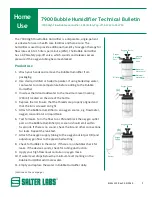
4
www.UsePhoenix.com • [email protected]
Toll-Free 1-800-533-7533
temperature inside the condenser rises. By removing the
bypass magnet from the bypass openings, additional airflow
is directed over the condenser and less airflow is directed
across the evaporator. The airflow differences improve the
dehumidifier efficiency.
Below 90F – When the Phoenix 200 HT is used in low
temperature conditions (below 90F), the refrigerant
temperature inside the condenser lowers. By adding a
bypass magnet to the bypass openings, additional airflow
is added through the evaporator. The airflow difference
improves the dehumidifier efficiency.
3 Maintenance
3.1 Air Filter
The Phoenix 200HT is equipped with a pleated fabric air filter
that must be checked regularly. The standard filter is a MERV-
11 high efficiency filter. Operating the unit with a dirty filter
will reduce the dehumidifier’s capacity and efficiency and
may cause the compressor to cycle off and on unnecessarily
on the defrost control.
IMPORTANT:
DO NOT operate the unit without the filter
or with a less effective filter as the heat exchanger and
coils inside the unit could become clogged and require
disassembly to clean.
3.2 Storage
There are two issues to consider when the Phoenix 200HT
is stored between uses. Both pertain to the water trapped
in the unit: damage caused by freezing or biological growth.
The effect of the trapped water can be greatly reduced if
precautions are taken to remove as much as possible before
storage.
1. Use the pump purge switch (see Sec. 2.7) to reduce the
water level in the reservoir.
2. Stretch the hose flat to drain it completely. Raise one
end above your head and spool to drain water out of the
other end.
If the unit will not be exposed to freezing temperatures, an
alternative to reduce biological growth is to flush the unit
with a bio-fungicide that is approved for use with copper,
aluminum and polyethylene. To flush:
1. Run the hose to a drain.
2. Plug in the unit but do not turn it on.
3. Remove the air filter. Slowly pour a quart of the chemical
through the heat exchanger
4. Hold in the pump purge switch to reduce the water level
in the reservoir.
5. Flush with water.
4 Service
CAUTION: Servicing the Phoenix 200HT with its high
pressure refrigerant system and high voltage circuitry
presents a health hazard which could result in death,
serious bodily injury, and/or property damage. Only
qualified service people should service this unit.
4.1 Technical Description
The Phoenix 200HT uses a refrigeration system similar to an
air conditioner’s to remove heat and moisture from incoming
air, and to add heat to the air that is discharged (see Fig. 2).
Hot, high pressure refrigerant gas is routed from the
compressor to the condenser coil (see Figure 2). The
refrigerant is cooled and condensed by giving up its heat
to the air that is about to be discharged from the unit. The
refrigerant liquid then passes through a filter/drier and
capillary tubing which cause the refrigerant pressure and
temperature to drop. It next enters the evaporator coil where
it absorbs heat from the incoming air and evaporates.
The evaporator operates in a flooded condition, which means
that all the evaporator tubes contain liquid refrigerant during
normal operation. A flooded evaporator should maintain
constant pressure and temperature across the entire coil,
from inlet to outlet.
The mixture of gas and liquid refrigerant enter the
accumulator after leaving the evaporator coil. The
accumulator prevents any liquid refrigerant from reaching the
compressor. The compressor evacuates the cool refrigerant
gas from the accumulator and compresses it to a high
pressure and temperature to repeat the process.
Figure 2: Refrigeration system



























